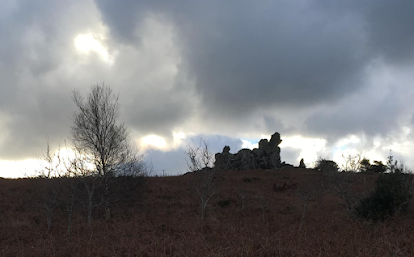This is a lovely photo posted on Facebook by Sian May -- reminding us of the extraordinary fragility of the rhyolite crags that stand proud in the landscape above Trefgarn Gorge in mid-Pembrokeshire. There are two upstanding tors -- Maiden Castle (called by locals "the family of lions") and the bulky and more solid Lion Rock. They are so delicate that many have speculated that they cannot possibly have been covered by glacier ice during the LGM / Late Devensian.
Well, I think that they must have been, since there are apparently fresh glacial deposits not far away, both to the north and the south of the crags. I have discussed the "survival dilemma" before on this blog, and was convinced that these crags were NOT glaciated around 26,000 years ago. But I have changed my mind, as more and more evidence has accumulated to demonstrate the true extent of LGM glaciation in West Wales and the capacity for fragile landforms to survive under thick ice where certain glaciological conditions are met. What we don't know (as yet) is the extent to which there has been post-glacial modification of these tors. Could Maiden Castle, for example, have been seriously damaged by LGM ice, to the extent that parts of it simply fell apart in the long cold spell between 26,000 yrs BP and 10,000 yrs BP? And could such a disintegration be responsible for the present-day "fragility" of the feature?
The significance of tors in glaciated lands: a view from the British Isles
by ADRIAN M. HALL, DAVID E. SUGDEN
Du continent au bassin versant. h éories et pratiques en géographie physique
(Hommage au Professeur Alain Godard)
2007, Presses Universitaires Blaise-Pascal,
ISBN - 978-2-84516-335-5
Quote:
Quote:
The survival of fragile tors from summits, ridges and lowlands in other formerly glaciated
regions probably requires former covers of cold-based ice throughout the cold stages of the
Middle and Late Pleistocene. The covers maybe localised and equate to "cold-bed patches"
(Kleman et al., 1994), where a carapace of cold ice protects the glacier bed from erosion. Where
tors show no modification then the ice is not only cold-based but also barely deforming across
the tor site. Such locations would be those covered by thin or diverging ice flow (Sugden, 1974,
1978). The first stages of modification involve the entrainment of blocks from the tor summit
and margin. Modest distances of block transport and the absence of evidence of basal meltwater
in form of plucking on the lee side of the form indicates erosion under cold-based ice (Hall and
Phillips, 2006a), but the degree of modification of the tor remains modest. Only in the later stages
of tor destruction, when the tor is reduced to a plinth or slab, do the processes of lee-side plucking and abrasion become important and this marks the onset of basal sliding (Andre, 2004; Hall and Phillips, 2006a). In an ice-sheet situation basal sliding is favoured by deeper converging ice flow, leading to a general absence of tors from glaciated lowlands and valleys and an inverse relationship between erosion rates and altitude (Briner et al., 2003; Kleman and Stroeven, 1997; Staiger et al., 2004; Sugden et al., 2005).
I like the idea of "cold-bed patches" and will investigate further......


No comments:
Post a Comment